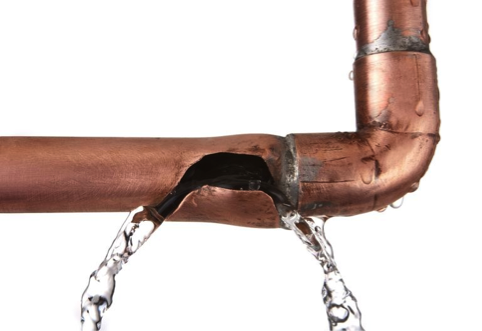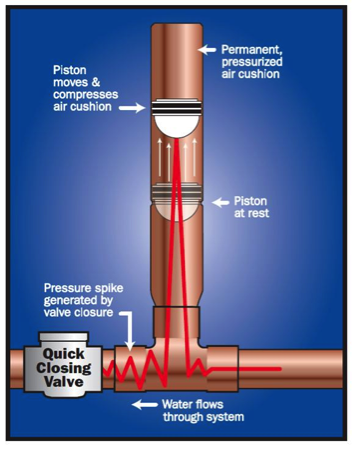What Do a Hammer and Water Have in Common?
The Water Hammer Phenomenon
The water hammer phenomenon is defined as a quick spike in pressure stemming from the inherent kinetic energy (momentum) in all flowing water, which starts at the culprit valve but also
extends throughout the entire system.
When a pipe is suddenly closed at the outlet (downstream), the mass of water before the closure is still moving, thereby building up high pressure and resulting in a shock wave. The result may be
heard as a loud bang, repetitive banging (as the shock wave travels back and forth in the plumbing system), or as some shuddering. A water hammer can cause pipelines to break if the pressure is
high enough. A water hammer may occur when the water supply valve inside the humidifier shuts off the water flow. The hammering action is capable of damaging joints, causing connections to come
loose, and causing ruptures and connections in the pipe.

Rupture in copper pipe
The following items may be installed to reduce or eliminate the water hammer:
A water hammer is most often caused by water pressure that's too high. If the pressure is above 70 psi, a pressure regulator should be installed. The pressure regulating valve should help maintain a
safe and even water pressure and thereby prevent the water hammer.
When reducing pressure is not feasible or is ineffective, install the necessary air chambers to prevent the water hammer. Air chambers act as cushions to prevent water from slamming against the piping.
Due to air compression, it absorbs the shock of the fast-moving water before it has a chance to slam against the end of the pipe.
A hydropneumatic device, similar in principle to a shock absorber, called a 'Water Hammer Arrestor' can be installed between the water pipe and the humidifier, to absorb the shock and stop the banging.
A water hammer arrestor is a very simple device consisting of a vertical pipe with an internal plastic piston. Normally, the piston rests at the bottom of the pipe, but when a shock wave travels
through the system, it forces the piston up into the pipe. The piston absorbs the force of the shock wave, preventing water hammer.

Water hammer arrestor
Neptronic recommends the installation of a water hammer arrestor, to absorb hydraulic shock and minimize water hammer when the fill valve closes.